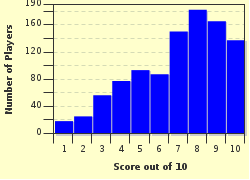Quiz Answer Key and Fun Facts
1. What machine gun was called "Hitler's buzzsaw"?
2. What grenade was known as the potato masher?
3. What rifle made a distinctive "ping" sound when the last round was ejected?
4. What submachine gun had the highest rate of fire?
5. What gun was adapted as an anti-tank gun from its original role as an anti-aircraft gun?
6. What was the most feared German tank of the war?
7. What WWII truck was nicknamed the 'Deuce and a half'?
8. What was one of only three jet fighters, besides the HE-162 and the Meteor, used in World War II?
9. What was the most widely used bomber in the European and Pacific Theaters?
10. What landing craft could drop troops off on any stretch of land?
Source: Author
baller7194
This quiz was reviewed by FunTrivia editor
bloomsby before going online.
Any errors found in FunTrivia content are routinely corrected through our feedback system.

